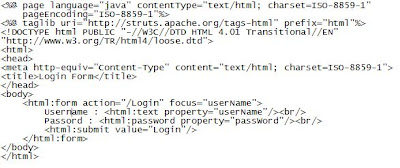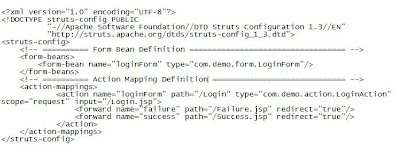01 | function go(url) |
02 | { |
03 | window.location = url; |
04 | } |
05 |
06 | function delete(url) |
07 | { |
08 | var isOK = confirm("Are you sure to delete?"); |
09 | if(isOK) |
10 | { |
11 | go(url); |
12 | } |
13 | } |
01 | function go(url) |
02 | { |
03 | window.location = url; |
04 | } |
05 |
06 | function delete(url) |
07 | { |
08 | var isOK = confirm("Are you sure to delete?"); |
09 | if(isOK) |
10 | { |
11 | go(url); |
12 | } |
13 | } |
Posted by Alex Rabe at 10:53 PM 0 comments
Labels: javascript
Posted by Alex Rabe at 9:52 PM 0 comments
Labels: database back
Posted by Alex Rabe at 11:44 PM 0 comments
Labels: Database
Posted by Alex Rabe at 5:34 AM 0 comments
Labels: Struts Example
Posted by Alex Rabe at 4:25 AM 0 comments
Labels: Struts, Struts Framework
Feature | Struts 1 | Struts 2 |
Action classes | Struts1 extends the abstract base class by its action class. The problem with struts1 is that it uses the abstract classes rather than interfaces. | While in Struts 2, an Action class implements an Action interface, along with other interfaces use optional and custom services. Struts 2 provides a base ActionSupport class that implements commonly used interfaces. Although an Action interface is not necessary, any POJO object along with an execute signature can be used as an Struts 2 Action object. |
Threading Model | Struts 1 Actions are singletons therefore they must be thread-safe because only one instance of a class handles all the requests for that Action. The singleton strategy restricts to Struts 1 Actions and requires extra care to make the action resources thread safe or synchronized while developing an application. | Struts 2 doesn't have thread-safety issues as Action objects are instantiated for each request. A servlet container generates many throw-away objects per request, and one more object does not impose a performance penalty or impact garbage collection. |
Servlet Dependency | Actions are dependent on the servlet API because HttpServletRequest and HttpServletResponse is passed to the execute method when an Action is invoked therefore Struts1. | Container does not treat the Struts 2 Actions as a couple. Servlet contexts are typically represented as simple Maps that allow Actions to be tested in isolation. Struts 2 Actions can still access the original request and response, if required. While other architectural elements directly reduce or eliminate the need to access the HttpServetRequest or HttpServletResponse. |
Testability | Struts1 application has a major problem while testing the application because the execute method exposes the Servlet API. Struts TestCase provides a set of mock object for Struts 1. | To test the Struts 2 Actions instantiate the Action, set the properties, and invoking methods. Dependency Injection also makes testing easier. |
Harvesting Input | Struts 1 recieves an input by creating an ActionForm object. Like the action classes, all ActionForms class must extend a ActionForm base class. Other JavaBeans classes cannot be used as ActionForms, while developers create redundant classes to receive the input. DynaBeans is the best alternative to create the conventional ActionForm classes. | Struts 2 requires Action properties as input properties that eliminates the need of a second input object. These Input properties may be rich object types, since they may have their own properties. Developer can access the Action properties from the web page using the taglibs. Struts 2 also supports the ActionForm pattern, POJO form objects and POJO Actions as well. |
Expression Language | Struts1 integrates with JSTL, so it uses the JSTL EL. The EL has basic object graph traversal, but relatively weak collection and indexed property support. | Struts 2 can use JSTL, but the framework also supports a more powerful and flexible expression language called "Object Graph Notation Language" (OGNL). |
Binding values into views | Struts 1 binds objects into the page context by using the standard JSP mechanism. | Struts 2 uses a ValueStack technology to make the values accessible to the taglibs without coupling the view to the object to which it is rendering. The ValueStack strategy enables us to reuse views across a range of types, having same property name but different property types. |
Type Conversion | Struts 1 ActionForm properties are almost in the form of Strings. Commons-Beanutils are used by used by Struts 1 for type conversion. Converters are per-class, which are not configurable per instance. | Struts 2 uses OGNL for type conversion and converters to convert Basic and common object types and primitives as well. |
Validation | Struts 1 uses manual validation that is done via a validate method on the ActionForm, or by using an extension to the Commons Validator. Classes can have different validation contexts for the same class, while chaining to validations on sub-objects is not allowed. | Struts 2 allows manual validation that is done by using the validate method and the XWork Validation framework. The Xwork Validation Framework allows chaining of validations into sub-properties using the validations defined for the properties class type and the validation context. |
Control of Action Execution | Each module in Struts 1 has a separate Request Processors (lifecycles), while all the Actions in the module must share the same lifecycle. | In Struts 2 different lifecycles are created on a per Action basis via Interceptor Stacks. Custom stacks are created and used with different Actions, as required.s |
Posted by Alex Rabe at 3:30 AM 0 comments
Posted by Alex Rabe at 5:51 AM 0 comments
Labels: Hibernate

Posted by Alex Rabe at 12:14 AM 0 comments
Labels: eClipse
Posted by Alex Rabe at 10:42 AM 0 comments
Labels: forward methods, include methods, RequestDispatcher, ServletConfig, ServletContext
Posted by Alex Rabe at 2:10 AM 0 comments
Labels: Hibernate Features
Hibernate is an open source object (relational) mapping library for the Java language,that provides persistent classes and logic without caring how to handle the data.
Persistance in Java ( Hibernate ) is storing data in a relational databse using SQL.
Posted by Alex Rabe at 1:58 AM 0 comments
Posted by Alex Rabe at 2:17 AM 0 comments
Login Form Example With Struts
This post will show you how a form process in struts 1 framework. We will create a login form and then using struts 1 we will verify the authentication of the user. This example will take following steps :
package com.demo.form;
import javax.servlet.http.HttpServletRequest;
import org.apache.struts.action.ActionForm;
import org.apache.struts.action.ActionMapping;
public class LoginForm extends ActionForm {
private static final long serialVersionUID = -3491637470205228033L;
private String userName = null;
private String passWord = null;
public String getUsername() {
return username;
}
public void setUsername(String userName {
this.userName = userName;
}
public String getPassword() {
return passWord;
}
public void setPassword(String passWord) {
this.passWord = passWord;
}
@Override
public void reset(ActionMapping mapping, HttpServletRequest request) {
this.passWord = null;
}
}
public class LoginAction extends Action {
@Override
public ActionForward execute(ActionMapping mapping, ActionForm form,
HttpServletRequest request, HttpServletResponse response)
throws Exception {
LoginForm loginForm = (LoginForm)form;
if(loginForm.getUsername() == null || loginForm.getPassword() == null ||
!loginForm.getUsername().equalsIgnoreCase("abc") || !loginForm.getPassword().equals("123")){
return mapping.findForward("failure");
}
else
return mapping.findForward("success");
}
}

Posted by Alex Rabe at 1:16 AM 0 comments
Labels: Login Form Struts